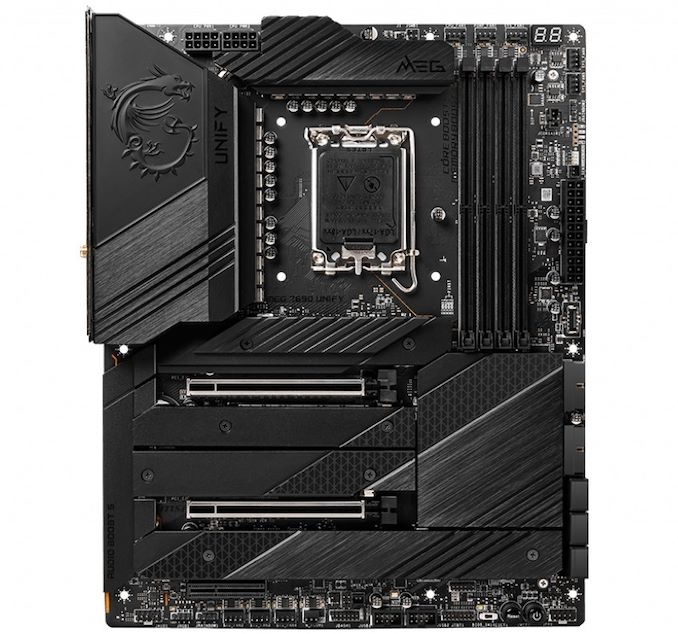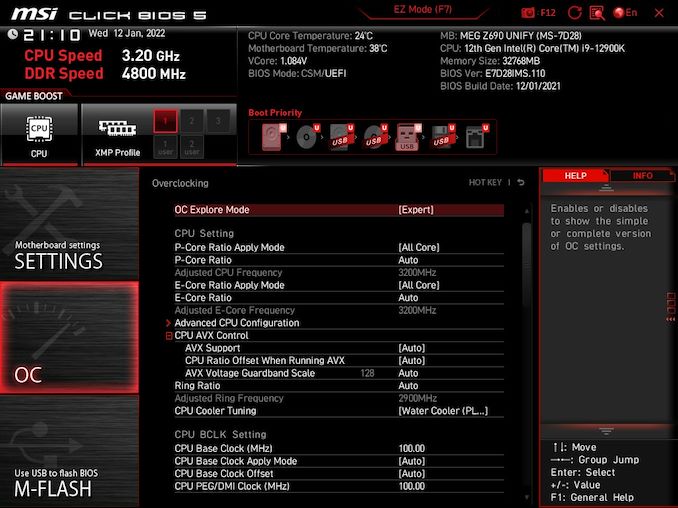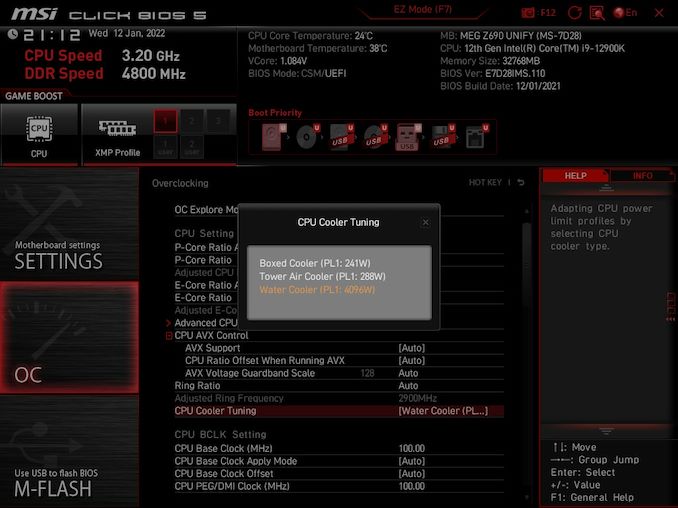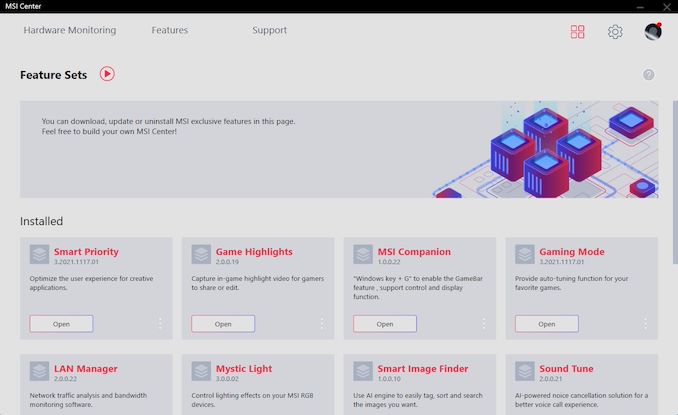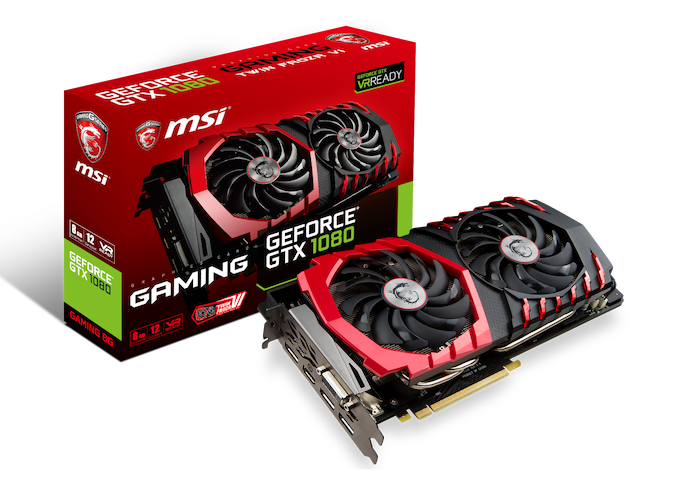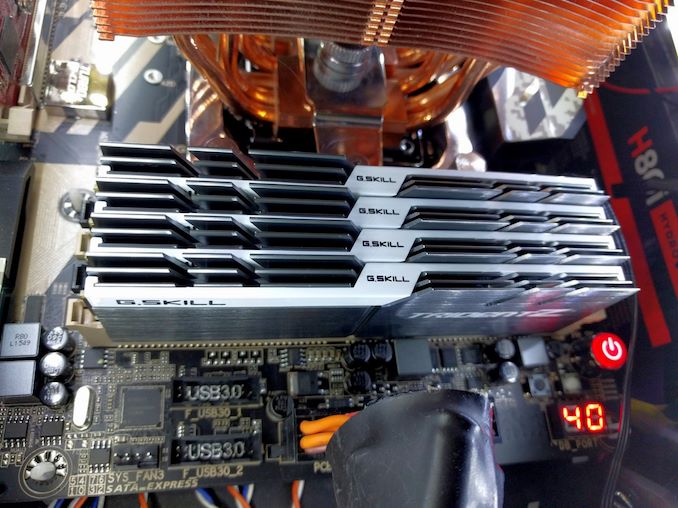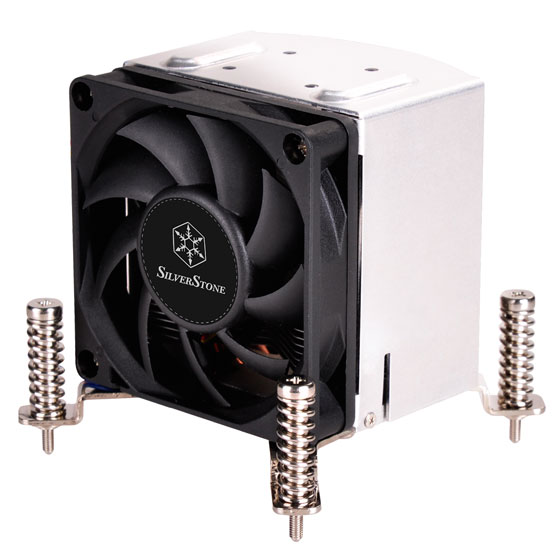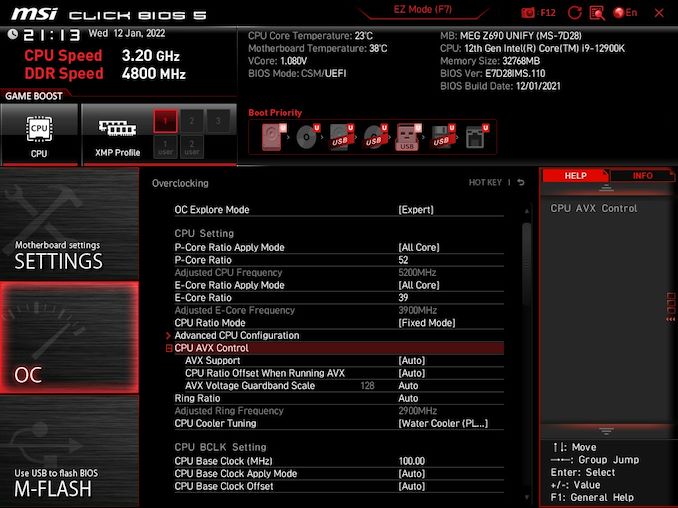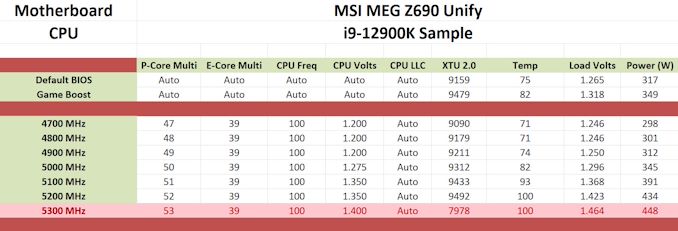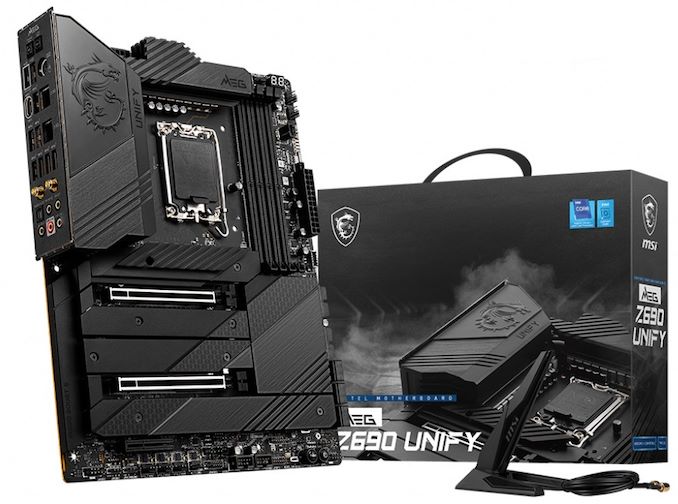
The MSI MEG Z690 Unify (DDR5) Motherboard Review: The All-Black Option
2022-01-18With the Unify, we are looking at a premium model with support for DDR5 memory, but it doesn’t feature any RGB LED lighting. The MSI MEG Z690 Unify represents MSI’s Enthusiast Gaming series, which combines elements of an enthusiast-level motherboard, but with all the features designed for users to make the most of the latest controller sets and 12th gen features. Some of the features include five M.2 slots, support for DDR5-6666 memory, dual 2.5 GbE and Wi-Fi 6E networking, as well as an advertised 21-phase power delivery.
In addition to the launch of Intel’s 12th generation processors we overviewed and analyzed 80+ Z690 models across two articles – one for DDR5 motherboards and one for DDR4 motherboards. Designed around the LGA1700 socket, the Z690 chipset brings several benefits compared to the previous generation, such as DDR5. DDR5 which offers better performance than DDR4, but Intel also includes support for DDR4 memory. This splits Z690 into two different segments so no Z690 board can support DDR5 and DDR4 memory simultaneously; it’s either one or the other.
All of the support for PCIe 5.0 (16 x PCIe 5.0 and 4 x PCIe 4.0 lanes) comes directly from the Intel 12th gen processors, with the Z690 chipset offering 12 x PCIe 4.0 and 16 PCIe 3.0 lanes. There is also a PCIe 4.0 x8 uplink between the chipset and the processor. Intel includes a Wi-Fi 6E PHY, native USB 3.2 G2x2 connectivity, as well as overclocking support, as we typically find on its flagship series of Z models.
Below is a list of our Intel 12th gen reviews and the relevant motherboard overviews:
- The Intel 12th Gen Core i9-12900K Review: Hybrid Performance Brings Hybrid Complexity
- The Intel Z690 Motherboard Overview (DDR5): Over 50+ New Models
- The Intel Z690 Motherboard Overview (DDR4): Over 30+ New Models
It feels like an eon ago since MSI initially unveiled its X99A Godlike Gaming at Computex 2015, which coincidently, as it claimed, was the world’s first RGB-enabled motherboard. During that time, RGB has been a driving factor in sales, giving users some form of customization to look at. Despite what people might think, RGB doesn’t make your hardware run any faster than the speed stripes you see on automobiles.
Meet world’s first RGB LED motherboard, the #MSI X99A GODLIKE GAMING. Make this truly ONE BOARD TO RULE ALL! pic.twitter.com/xBRZ3wZhwE
— MSI Gaming (@msigaming) June 9, 2015
I remember the days when I would install single-color cold cathode tubes in my PC case to add a bit of sparkle when computer components such as motherboards and graphics cards were generic in aesthetic, with ugly green or brown PCBs, even motherboards with red, black, sometimes orange finishes on the heatsinks to make them stand out from the rest. Now we are in the age of RGB, where if every component in your system isn’t flashing with rainbow-inspired unicorn vomit, you’re not considered cool.
MSI adapted itself into the culture of everything must have RGB LEDs, but it unveiled a series marketed as being RGB free, like it was an actual feature not to have a feature (if you can imagine that). There are the ‘Carbon’ variants of some of MSI’s motherboards, but this was codified under the Unity line.
The latest RGB-free iteration from the MSI Unify series is based on the Z690 chipset, the MSI MEG Z690 Unify. The Unify series prides itself on not conforming itself to the RGB crowd, focusing more on features over flashy aesthetics. The MSI MEG Z690 Unify has a sleek all-black aesthetic, with metallic black heatsinks, a sizeable rear panel cover, but don’t mistake its elegant design as a weakness. Under the hood, the Z690 Unify is packing an impressive feature set. Some of the most notable include a large 21-phase power delivery for overclockers and enthusiasts, with a solid dual Intel 2.5 GbE controller pairing and Wi-Fi 6E networking configuration offering users a varied selection of connectivity. There are also two full-length PCIe 5.0 slots, another new addition to Alder Lake and Z690, with support for x16 and x8/x8, although there’s also a half-length PCIe x4 slot present too.
There’s plenty of storage support available, too, with five M.2 slots in total, four of these supporting PCIe 4.0 x4 drives and one with support for PCIe 3.0 x4 varieties. MSI includes six SATA ports for SATA devices and storage, four of which come from the chipset with support for Intel RAID 0, 1, 5, and 10 arrays. As the MSI MEG Z690 Unify is a premium option, it supports the latest DDR5 memory, including speeds of up to DDR5-6666, with a combined capacity of 128 GB supported across its four slots. MSI also includes two USB 3.2 G2x2 Type-C ports, one on the rear panel and one available through a front panel header. Other USB support consists of nine Type-A ports; seven of these conform to USB 3.2 G2 and two to USB 2.0.
Briefly touching on performance, the MSI MEG Z690 Unify did well in all three sets of testing – system, compute, and gaming. It is competitive compared with other Z690 models we’ve tested so far, with its most significant win coming in DPC latency.
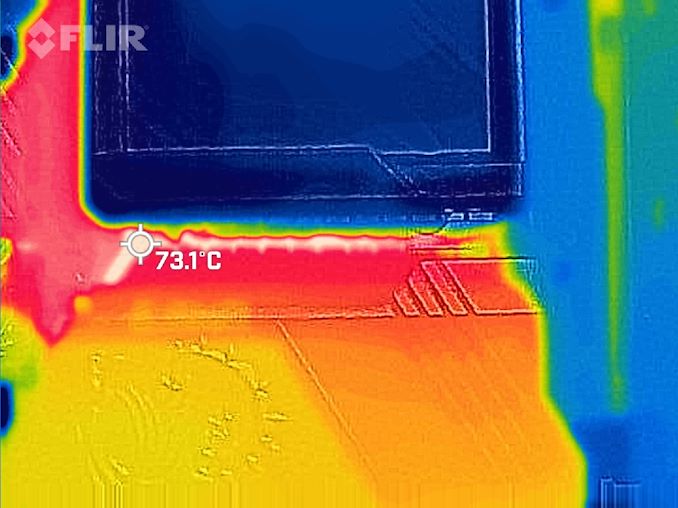
The MSI MEG Z690 Unify undergoing our VRM thermal testing
When it came to overclocking, the Unify showed that although it might look like a sleeper, it has some solid potential for pushing unlocked Alder Lake processors. Despite the biggest limitations of this coming through cooling, our maximum stable overclock was at 5.3 GHz on the P-cores and 1.400 V on the CPU VCore, which hit 100°C and 448 W in terms of power draw at the wall. We did experience over generous amounts of VDroop when comparing the CPU VCore values we set in the BIOS to what we reported at full-load. While the reporting software could perhaps be a little unreliable, the increase in power draw we noted did seem consistent with our results.
The MSI MEG Z690 Unify stands firm with an MSRP of $490, and looking at the $450 to $500 price point on Z690; there are a few options available. This includes the ASRock Z690 PG Velocita ($470), the ASUS ROG Strix Z690-E Gaming WIFI ($470), and the GIGABYTE Z690 Aorus Master ($470). Apart from the GIGABYTE, which we will be reviewing soon with 10 GbE, everything else is on a similar level in terms of features and specifications. Of course, there are the aesthetic differences to consider as well, with the Unify the only one from this bunch that prides itself on being RGBless, with an elegant yet premium-looking design. The other key factor also comes down to performance, which we’re about to explore throughout this review. It’s time to see whether or not the Unify has the edge over the competition and if it’s the sub $500 Z690 model users should be looking at.
Read on for our extended analysis.
Decked out in all-black, the MSI MEG Z690 Unify is a prime example of a motherboard that doesn’t need RGB LED lighting to look good. Despite not including any RGB LED lighting on the board directly, it does have plenty of headers for users looking to add their own RGB LED strips, including one 4-pin RGB, two 3-pin RAINBOW LED, and one 3-pin Corsair RGB header. From left to right, there’s a large metal rear panel cover with large and rugged power delivery heatsinks. Even towards the lower portion of the board, MSI covers as much of the PCB as possible with a wave of M.2 heatsinks and a large flat black chipset heatsink.
For cooling, MSI includes a total of eight 4-pin headers, with one for a CPU fan, one for a water pump, as well as six designated for chassis fans. Located in the top right-hand corner of the board is a two-digit LED debugger for diagnosing system POST faults. There’s also a dual BIOS selector switch, a power button, and a reset button, which can be found in the bottom right-hand corner.
Located in the top right-hand corner of the ATX-sized PCB is a total of four memory slots. The memory slots have one installation clasp per slot, which is found at the top of the slot. MSI includes support for fast speeds of up to DDR5-6666, with a combined tested capacity limit of 128 GB.
Focusing on the bottom half of the motherboard, the MSI MEG Z690 Unify has two full-length PCIe 5.0 slots that can operate at x16 and x8/x8, with a half-length slot electronically locked down to PCIe 3.0 x4. On the storage side of things, MSI is using a lot of PCIe lanes in this area, with a total of five M.2 slots. This includes three PCIe 4.0 x4, one PCIe 4.0 x4/SATA, as well as one PCIe 3.0 x4 M.2 slot.
Each of the M.2 slots includes M.2 heatsink coverage, while for SATA-based devices and drives, MSI includes six SATA ports. Four of the SATA have support for RAID 0, 1, 5, and 10 arrays, while an ASMedia ASM1061 SATA controller drives the remaining two SATA ports.
The MSI MEG Z690 Unify has a large 21-phase power delivery, with nineteen Renesas RAA22010540 105 A smart power stages dedicated to the CPU VCore, and offers up to 1995 A just for the processor. This is more than enough for overclockers to push things to the limit with both ambient and sub-ambient cooling types. There are two RAA22010540 40A power stages for the SoC, with the power delivery being regulated by a Renesas RAA229131 20-phase PWM controller operating in a 19+2 configuration. Providing power, the processor is a pair of 8-pin 12 V EPS CPU power connectors.
Cooling the large 21-phase power delivery is a chunky heatsink with two main sections. The main section is built around the large rear panel cover with a single heat pipe connecting both sections of the power delivery heatsinks together. It has quite a bit of weight to it and includes deeply channeled fins designed to catch passive airflow when installed into a chassis.
Looking at the audio section of the PCB, MSI is using a Realtek ALC4080 HD audio codec with no EMI shielding. It uses five large Japanese Gold Nichion audio capacitors, with a flank of six smaller ones. MSI includes PCB separation from the rest of the board, with a thin metal cover that hides it away when installed into a chassis.
On the rear panel, the Z690 Unify includes one USB 3.2 G2x2 Type-C, seven USB 3.2 G2 Type-A, and two USB 2.0 ports. The Unify lacks any video outputs, so no integrated graphics support is featured at all. For integrated audio, there are five 3.5 mm audio jacks and S/PDIF optical output powered by a Realtek ALC4080 HD audio codec, while MSI also includes a PS/2 combo port, a clear CMOS button, and a BIOS Flashback button.
MSI also has a solid array of networking capabilities on the Z690 Unify, with two Intel I225-V 2.5 GbE controllers and a premium Intel AX210 Wi-Fi 6E CNVi offering both wireless and BT 5.2 connectivity.
What’s in the Box
Included in the box with the MSI MEG Z690 Unify is a varied and wide selection of accessories. The most notable of these include the Intel AX210 WI-Fi 6E CNVi antenna, MSI branded screwdrivers, an MSI cleaning brush, a USB stick with the relevant software and drivers, as well as four black SATA cables. MSI also includes M.2 screw kits, cable stickers, an MSI case badge, a user manual, and RGB extension cables.
- User manual
- Quick installation guide
- MSI MEG sticker sheet
- MSI cable stickers
- Reward Program card
- Product catalog
- Registration card
- 2 x M.2 screw/standoffs
- 2 x EZ M.2 clips
- EZ Front panel cable
- 4 x SATA cables
- 1 to 2 Y RGB LED extension cable
- Corsair RGB LED extension cable
- Rainbow RGB LED extension cable
- MSI Cleaning brush
- Intel AX210 Wi-Fi 6E antenna
- MSI Case badge
- Driver and software installation USB flash drive
The MSI MEG Z690 Unify is using the familiar Click BIOS 5 UEFI firmware, which we’ve seen over numerous generations of MSI’s motherboards on both AMD and Intel platforms. Focusing on the overall theme and GUI, it has a primarily black background, with elements of red highlights, and white and grey text. MSI includes two different modes, the basic mode for novices, and the advanced mode for the experienced.
Entering the firmware for the first time which can be accessed during POST by pressing the Del or F2 keys, brings users to the basic mode. Within the basic mode, users can make basic and key alterations to the settings, including enabling X.M.P 3.0 profiles on compatible DDR5 memory kits, enabling or disabling the HD audio codec, enabling or disabling fTPM 2.0 for installing Windows 11, as well as getting a basic list of information on the processor, memory, storage, and installed fans.
Within the Advanced mode, users will find a whole host of customizable settings, from chipset-related settings, all the way to all of the board’s overclocking functions. All of the board’s overclocking settings can be found under the OC menu, with the firmware allowing users to alter and tweak Alder Lake-specific P-Core, E-Core, Cache, and memory-related settings such as frequency, and extensive options for latencies.
One of the most interesting features in the firmware from MSI is the ability to select between three different cooling profiles. Each of the profiles is relevant to the type of cooling installed and allows a different level of power to the processor. The boxed cooler or low-end air coolers limits TDP to 241 W to prevent thermally overpowering the cooler, while the tower air cooler profile which is more for the larger air coolers such as Noctua’s NH-D15 has a maximum TDP of 288 W. The water cooling profile completely removes power limits to the board, with a maximum output of up to 4096 W. It’s impressive and completely theoretical, but it does allow the board to put as much power into the processor as it requires.
The MSI Click BIOS 5 firmware is easy to navigate and offers plenty for novice and advanced users alike. We’ve become accustomed to this firmware over the years, and aside from the Z690 chipset and Intel Alder Lake specific features, not much has changed. It’s intuitive, responsive to our keyboard and mouse, and is stable with no issues encountered when testing.
One of the current trends in motherboard software is to bundle everything into one larger software application. Not only does this make everything relevant easy to find, but it reduces the number of applications and shortcuts on the desktop. Virtually all of MSI’s software barring audio for the MEG Z690 Unify is available to use, or download and install via the MSI Center application.
Inside of the MSI Center software which acts as a central hub to all of its other key applications which offers a wide variety of different functionality. Some of the most notable applications include the Mystic Light RGB utility, which allows users to customize any additional devices that may be connected, the System Diagnosis panel which shows storage disk and memory usage, and allows users to free up disk space at the click of a button. The Smart Priority panel allows users to assign priority to applications and games, or allow the AI (assisted intelligence) to decide for itself.
There is also the Live Update screen where users can update the board’s drivers to the latest versions, along with a dedicated Hardware Monitor which shows a detailed display of temperatures, current voltages from an array of sensors. There is also MSI’s True Color, which allows users to customize the visual experience based on some useful user profiles such as EyeRest, Game, Movie, as well as the option to customize and create their own profile.
MSI also includes a custom skinned version of the system monitoring CPU-Z utility, although the version available at the time of writing from the MSI website is v1.97. The CPU-Z utility itself is on v1.99, so we recommend downloading this at present from the official CPUID website. MSI also includes the Nahimic audio software which allows users to enhance the auditory experience for both gaming, films, and surround sound, although the Realtek Audio Console can also be downloaded directly from the Microsoft store.
There are plenty of applications available for users to access some of MSI’s specific software features, although there is no overclocking software provided. Instead, MSI relies on using Intel’s own XTU software and benchmarking tool.
The MSI MEG Z690 Unify is a premium ATX motherboard that sits below both the Godlike and Ace series. Representative of its MEG enthusiast gaming series, the Z690 Unify has plenty of features and controller sets to keep both enthusiasts and performance users satisfied. One of the biggest features of Intel’s 12th gen and Z690 is PCIe 5.0, and MSI includes two full-length PCIe 5.0 slots operating at x16 and x8/x8, with one half-length slot electronically locked down to PCIe 3.0 x4.
For storage, MSI includes a total of five M.2 slots, with three operating at PCIe 4.0 x4, one with PCIe 4.0 x4 and SATA support, as well as a fifth PCIe 3.0 x4 M.2 slot. MSI has two sets of SATA, four of which support RAID 0, 1, 5, and 10 arrays, while another two are made available by the use of an ASMedia ASM1061 SATA controller. The MSI MEG Z690 Unify also has support for super-fast DDR5-6666 memory, with a combined capacity of up to 128 GB across four memory slots.
Focusing on cooling, the Z690 Unify has eight 4-pin headers, with one for a CPU fan, one for a water pump, and six for chassis fans.
| MSI MEG Z690 Unify ATX Motherboard | |||
| Warranty Period | 3 Years | ||
| Product Page | Link | ||
| Price | $490 | ||
| Size | ATX | ||
| CPU Interface | LGA1700 | ||
| Chipset | Intel Z690 | ||
| Memory Slots (DDR4) | Four DDR5 Supporting 128 GB Dual-Channel Up to DDR5-6666 |
||
| Video Outputs | N/A | ||
| Network Connectivity | 2 x Intel I225-V 2.5 GbE Intel AX210 Wi-Fi 6E |
||
| Onboard Audio | Realtek ALC4080 | ||
| PCIe Slots for Graphics (from CPU) | 2 x PCIe 5.0 (x16, x8/x8) | ||
| PCIe Slots for Other (from PCH) | 1 x PCIe 3.0 x4 | ||
| Onboard SATA | Four, RAID 0/1/5/10 (Z690) Two (ASMedia) |
||
| Onboard M.2 | 3 x PCIe 4.0 x4 1 x PCIe 4.0 x4/SATA 1 x PCIe 3.0 x4 |
||
| Onboard U.2 | N/A | ||
| Thunderbolt 4 (40 Gbps) | N/A | ||
| USB 3.2 (20 Gbps) | 1 x USB Type-C (Rear panel) 1 x USB Type-C (One header) |
||
| USB 3.2 (10 Gbps) | 7 x USB Type-A (Rear panel) 1 x USB Type-C (One header) |
||
| USB 3.1 (5 Gbps) | 4 x USB Type-A (Two headers) | ||
| USB 2.0 | 2 x USB Type-A (Rear panel) 4 x USB Type-A (Two headers) |
||
| Power Connectors | 1 x 24-pin Motherboard 2 x 8-pin CPU |
||
| Fan Headers | 1 x 4-pin CPU 1 x 4-pin Water pump 6 x 4-pin Chassis |
||
| IO Panel | 2 x Antenna Ports (Intel) 1 x PS/2 Combo port 1 x USB 3.2 G2x2 Type-C 7 x USB 3.2 G2 Type-A 2 x USB 2.0 Type-A 2 x RJ45 (Intel) 5 x 3.5 mm Audio jacks (Realtek) 1 x S/PDIF Optical output (Realtek) 1 x BIOS Flashback button 1 x Clear CMOS button |
||
In terms of connectivity, MSI is offering pretty much everything expected in the sub $500 Z690 motherboard space. On the rear panel are one USB 3.2 G2x2 Type-C, seven USB 3.2 G2 Type-A, and two USB 2.0 ports, with support for up to four USB 3.2 G1 Type-A (two headers), four USB 2.0 (two headers), and an additional USB 3.2 G2x2 Type-C ports through internal headers. Networking is premium with two Intel I225-V 2.5 GbE controllers, and an Intel AX210 Wi-Fi 6E CNVi. Audio is handled by a Realtek ALC4080 HD audio codec that powers five 3.5 mm audio jacks and S/PDIF optical output.
Test Bed
With some of the nuances with Intel’s Rocket Lake processors, our policy is to see if the system gives an automatic option to increase the power limits of the processor. If it does, we select the liquid cooling option. If it does not, we do not change the defaults. Adaptive Boost Technology is disabled by default.
| Test Setup | |||
| Processor | Intel Core i9-12900K, 125 W, $589 8P + 8E Cores, 24 Threads, 3.2 GHz Base (5.2 GHz P-Core Turbo) |
||
| Motherboard | MSI MEG Z690 Unify (BIOS 7D28v11) | ||
| Cooling | ASUS ROG Ryujin II 360 360 mm AIO | ||
| Power Supply | Corsair HX850 80Plus Platinum 850 W | ||
| Memory | Corsair Dominator Platinum RGB DDR5-4800 CL 38-40-40-78 2T (2 x 16 GB) |
||
| Video Card | MSI GTX 1080 (1178/1279 Boost) | ||
| Hard Drive | Crucial MX300 1TB | ||
| Case | Corsair Crystal 680X | ||
| Operating System | Windows 10 Pro 64-bit: Build 21H2 | ||
We must also thank the following:
Not all motherboards are created equal. On the face of it, they should all perform the same and differ only in the functionality they provide – however, this is not the case. The obvious pointers are power consumption, POST time and latency. This can come down to the manufacturing process and prowess, so these are tested.
For Z690 we are running using Windows 10 64-bit with the 20H2 update.
Power Consumption
Power consumption was tested on the system while in a single MSI GTX 1080 Gaming configuration with a wall meter connected to the power supply. Our power supply has ~75% efficiency > 50W, and 90%+ efficiency at 250W, suitable for both idle and multi-GPU loading. This method of power reading allows us to compare the power management of the UEFI and the board to supply components with power under load, and includes typical PSU losses due to efficiency. These are the real-world values that consumers may expect from a typical system (minus the monitor) using this motherboard.
While this method for power measurement may not be ideal, and you feel these numbers are not representative due to the high wattage power supply being used (we use the same PSU to remain consistent over a series of reviews, and the fact that some boards on our testbed get tested with three or four high powered GPUs), the important point to take away is the relationship between the numbers. These boards are all under the same conditions, and thus the differences between them should be easy to spot.



In our power testing, the Z690 Unify performed competitively against other Z690 models in all three stages, long idle, idle, and at full load.
Non-UEFI POST Time
Different motherboards have different POST sequences before an operating system is initialized. A lot of this is dependent on the board itself, and POST boot time is determined by the controllers on board (and the sequence of how those extras are organized). As part of our testing, we look at the POST Boot Time using a stopwatch. This is the time from pressing the ON button on the computer to when Windows starts loading. (We discount Windows loading as it is highly variable given Windows-specific features.)

Moving onto our non-UEFI POST time testing, the MSI gave us some respectable results. At default settings, we POSTed into Windows 10 in just under 18-seconds, and after disabling nonessential networking and audio controllers, we managed to shave this down to 16.7 seconds.
DPC Latency
Deferred Procedure Call latency is a way in which Windows handles interrupt servicing. In order to wait for a processor to acknowledge the request, the system will queue all interrupt requests by priority. Critical interrupts will be handled as soon as possible, whereas lesser priority requests such as audio will be further down the line. If the audio device requires data, it will have to wait until the request is processed before the buffer is filled.
If the device drivers of higher priority components in a system are poorly implemented, this can cause delays in request scheduling and process time. This can lead to an empty audio buffer and characteristic audible pauses, pops, and clicks. The DPC latency checker measures how much time is taken processing DPCs from driver invocation. The lower the value will result in better audio transfer at smaller buffer sizes. Results are measured in microseconds.

We test DPC latency out of the box with no tweaking or adjustments. The Z690 Unify so far (a lot more Z690 boards to go through) has the edge over other models tested, with a latency of 76.7 microseconds.
For our motherboard reviews, we use our short form testing method. These tests usually focus on if a motherboard is using MultiCore Turbo (the feature used to have maximum turbo on at all times, giving a frequency advantage), or if there are slight gains to be had from tweaking the firmware. We put the memory settings at the CPU manufacturers suggested frequency, making it very easy to see which motherboards have MCT enabled by default.
For Z690 we are running using Windows 10 64-bit with the 20H2 update.
Rendering – Blender 2.79b: 3D Creation Suite
A high profile rendering tool, Blender is open-source allowing for massive amounts of configurability, and is used by a number of high-profile animation studios worldwide. The organization recently released a Blender benchmark package, a couple of weeks after we had narrowed our Blender test for our new suite, however their test can take over an hour. For our results, we run one of the sub-tests in that suite through the command line – a standard ‘bmw27’ scene in CPU only mode, and measure the time to complete the render.

Rendering – Crysis CPU Render
One of the most oft used memes in computer gaming is ‘Can It Run Crysis?’. The original 2007 game, built in the Crytek engine by Crytek, was heralded as a computationally complex title for the hardware at the time and several years after, suggesting that a user needed graphics hardware from the future in order to run it. Fast forward over a decade, and the game runs fairly easily on modern GPUs, but we can also apply the same concept to pure CPU rendering – can the CPU render Crysis? Since 64 core processors entered the market, one can dream. We built a benchmark to see whether the hardware can.
For this test, we’re running Crysis’ own GPU benchmark, but in CPU render mode. This is a 2000 frame test, which we run over a series of resolutions from 800×600 up to 1920×1080. For simplicity, we provide the 1080p test here.

Rendering – Cinebench R23: link
Maxon’s real-world and cross-platform Cinebench test suite has been a staple in benchmarking and rendering performance for many years. Its latest installment is the R23 version, which is based on its latest 23 code which uses updated compilers. It acts as a real-world system benchmark that incorporates common tasks and rendering workloads as opposed to less diverse benchmarks which only take measurements based on certain CPU functions. Cinebench R23 can also measure both single-threaded and multi-threaded performance.

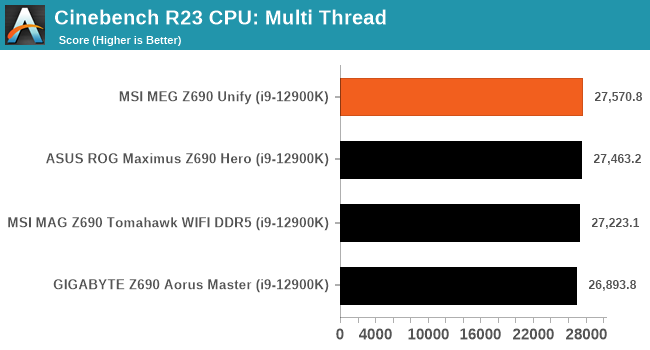
Synthetic – GeekBench 5: Link
As a common tool for cross-platform testing between mobile, PC, and Mac, GeekBench is an ultimate exercise in synthetic testing across a range of algorithms looking for peak throughput. Tests include encryption, compression, fast Fourier transform, memory operations, n-body physics, matrix operations, histogram manipulation, and HTML parsing.


Compression – WinRAR 5.90: link
Our WinRAR test from 2013 is updated to the latest version of WinRAR at the start of 2014. We compress a set of 2867 files across 320 folders totaling 1.52 GB in size – 95% of these files are small typical website files, and the rest (90% of the size) are small 30-second 720p videos.
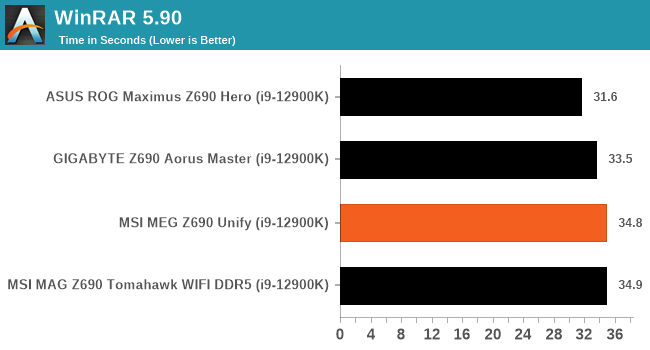
3DPMv2.1 – 3D Movement Algorithm Test: link
3DPM is a self-penned benchmark, taking basic 3D movement algorithms used in Brownian Motion simulations and testing them for speed. High floating point performance, MHz, and IPC win in the single thread version, whereas the multithread version has to handle the threads and loves more cores. For a brief explanation of the platform agnostic coding behind this benchmark, see my forum post here.

NAMD 2.13 (ApoA1): Molecular Dynamics
One frequent request over the years has been for some form of molecular dynamics simulation. Molecular dynamics forms the basis of a lot of computational biology and chemistry when modeling specific molecules, enabling researchers to find low energy configurations or potential active binding sites, especially when looking at larger proteins. We’re using the NAMD software here, or Nanoscale Molecular Dynamics, often cited for its parallel efficiency. Unfortunately the version we’re using is limited to 64 threads on Windows, but we can still use it to analyze our processors. We’re simulating the ApoA1 protein for 10 minutes, and reporting back the ‘nanoseconds per day’ that our processor can simulate. Molecular dynamics is so complex that yes, you can spend a day simply calculating a nanosecond of molecular movement.

For Z690 we are running using Windows 10 64-bit with the 20H2 update.
Civilization 6
Originally penned by Sid Meier and his team, the Civilization series of turn-based strategy games are a cult classic, and many an excuse for an all-nighter trying to get Gandhi to declare war on you due to an integer underflow. Truth be told I never actually played the first version, but I have played every edition from the second to the sixth, including the fourth as voiced by the late Leonard Nimoy, and it is a game that is easy to pick up, but hard to master.
Benchmarking Civilization has always been somewhat of an oxymoron – for a turn based strategy game, the frame rate is not necessarily the important thing here and even in the right mood, something as low as 5 frames per second can be enough. With Civilization 6 however, Firaxis went hardcore on visual fidelity, trying to pull you into the game. As a result, Civilization can taxing on graphics and CPUs as we crank up the details, especially in DirectX 12.

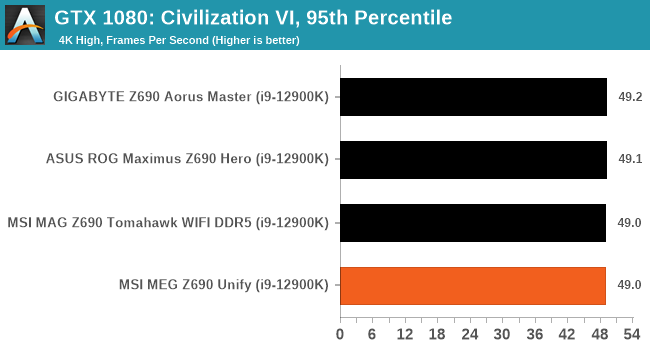
Shadow of the Tomb Raider (DX12)
The latest installment of the Tomb Raider franchise does less rising and lurks more in the shadows with Shadow of the Tomb Raider. As expected this action-adventure follows Lara Croft which is the main protagonist of the franchise as she muscles through the Mesoamerican and South American regions looking to stop a Mayan apocalyptic she herself unleashed. Shadow of the Tomb Raider is the direct sequel to the previous Rise of the Tomb Raider and was developed by Eidos Montreal and Crystal Dynamics and was published by Square Enix which hit shelves across multiple platforms in September 2018. This title effectively closes the Lara Croft Origins story and has received critical acclaims upon its release.
The integrated Shadow of the Tomb Raider benchmark is similar to that of the previous game Rise of the Tomb Raider, which we have used in our previous benchmarking suite. The newer Shadow of the Tomb Raider uses DirectX 11 and 12, with this particular title being touted as having one of the best implementations of DirectX 12 of any game released so far.
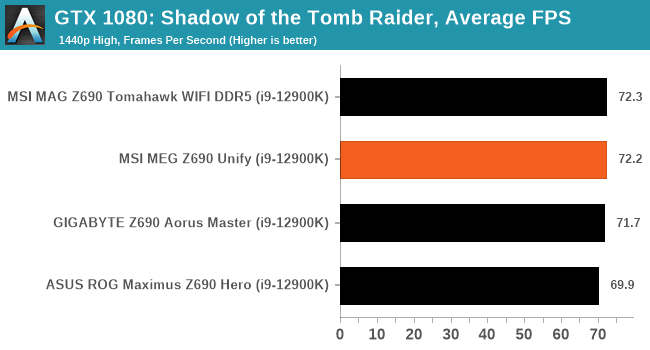

Strange Brigade (DX12)
Strange Brigade is based in 1903’s Egypt and follows a story which is very similar to that of the Mummy film franchise. This particular third-person shooter is developed by Rebellion Developments which is more widely known for games such as the Sniper Elite and Alien vs Predator series. The game follows the hunt for Seteki the Witch Queen who has arisen once again and the only ‘troop’ who can ultimately stop her. Gameplay is cooperative-centric with a wide variety of different levels and many puzzles which need solving by the British colonial Secret Service agents sent to put an end to her reign of barbaric and brutality.
The game supports both the DirectX 12 and Vulkan APIs and houses its own built-in benchmark which offers various options up for customization including textures, anti-aliasing, reflections, draw distance and even allows users to enable or disable motion blur, ambient occlusion and tessellation among others. AMD has boasted previously that Strange Brigade is part of its Vulkan API implementation offering scalability for AMD multi-graphics card configurations. For our testing, we use the DirectX 12 benchmark.
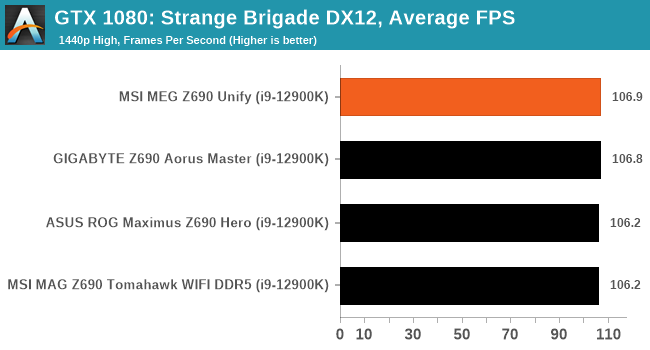
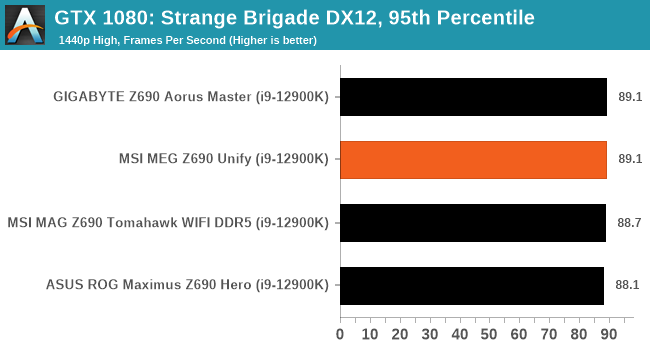
When it comes to overclocking on Intel’s 12th generation processors, Alder Lake has a new, yet important variable to consider. This is because not all of its cores are equal. Intel’s latest Alder Lake processors feature a hybrid design with P-cores (performance) and E-cores (efficient). Focusing on the Core i9-12900K, it has 8 P-Cores, 8 E-cores, and 24 threads in total. While Hyperthreading isn’t a new technology, the hybrid nature of Alder Lake combining two different types of CPU core is. The basic idea is that the P-cores do much of the front-loaded heavy lifting, the grunt work so to speak, while the E-cores assist in the background with high-threaded workloads with a much lower overall power draw than the P-cores.
Fundamentally when paired with a Z690 motherboard, both the P-core and E-cores are unlocked. This gives two areas for users to consider when it comes to overclocking. Having personally taken some time to investigate overclocking ability with the Core i9-12900K prior to diving into motherboard reviews, I found that the P-cores offer much more in terms of performance, while the E-cores don’t have as much headroom or scalability as the P-cores.
Another point of note when overclocking with Alder Lake, like with 11th gen and 10th gen, performance out of the box on both sets of cores are squeezed out via turbo, e.g, the P-Core Turbo on the Core i9-12900K is 5.2 GHz, while the E-Core turbo is 3.9 GHz. Make no mistake about it, Alder Lake is power-hungry, even more so from personal experience when overclocking than was the case with 11th gen Rocket Lake. This means adequate power being made available from a reliable and quality power supply is needed, as well as good quality and premium cooling such as AIOs, or even custom water cooling.
Experience with the MSI MEG Z690 Unify
Focusing on overclocking the Core i9-12900K with the MSI MEG Z690 Unify, it has plenty of customizable and configurable options available within its Click BIOS 5 UEFI firmware. All of the board’s processor and memory overclocking options can be found in the Advanced section of the BIOS under the OC section.
The OC section has extensive options for users to overclock both the processor and memory, although due to the Z690 Unify’s lack of video outputs, there are no options to overclock the integrated graphics. As the board has an over-engineered 21-phase (19+2) power delivery that is more than capable of allowing users to push Alder Lake with both ambient and sub-ambient cooling methods. For the CPU side of things, users can adjust the P-Core and E-Core ratios, with other controls such as AVX offsets so that when under these extreme workloads, the CPU cores can dial down a little and enhance overall system stability.
MSI also includes an LN2 mode for users looking to use this board to break world records, but there’s the MSI MEG Z690 Unify-X which is pretty much the same model, but with two DDR5 memory slots for better memory overclocking ability. There are also various voltage options for both the memory and CPU, while MSI also includes an LN2 mode designed for users to overclock the E-Cores, although these won’t as effective as pushing the P-Cores in terms of scalability and performance.
On the memory side of things, MSI includes a variety of customizable options in regards to frequency and memory latencies. This includes the two levels of Intel’s memory gears, Gear 1 which sets the memory controller to match the frequency in a 1:1 ratio, while Gear 2 operates at a ratio of 1:2 (IMC and DDR5).
Overall the MSI Click BIOS 5 firmware has everything a user needs to overclock Alder Lake, and with a premium power delivery, decent and varied selection of options available, even extreme overclockers could be confident of squeezing out all of that extra and delicious performance on offer.
Overclocking Methodology
Our overclocking methodology is as follows. We select the automatic overclock options and test for stability with the Intel XTU 2.0 benchmark and Prime95 to simulate high-end workloads. These stability tests aim to catch any immediate causes for memory or CPU errors.
For manual overclocks, based on the information gathered from the previous testing, start off at a nominal voltage and CPU multiplier, and the multiplier is increased until the stability tests are failed. The CPU voltage is increased gradually until the stability tests are passed. The process is repeated until the motherboard reduces the multiplier automatically (due to safety protocol) or the CPU temperature reaches a stupidly high level (105ºC+). Our testbed is not in a case, which should push overclocks higher with fresher (cooler) air.
Note: For the purposes of overclocking in our Z690 reviews, we will only be focusing on the P-cores (performance) as these simply scale better. The E-core (efficiency) will subsequently be set at 3.9 GHz throughout the entirety of our Z690 motherboard reviews.
Overclocking Results
Looking at overclocking performance when using our Core i9-12900K with the MSI MEG Z690 Unify, it’s notably mixed. First off the bat, even at default temperatures when using Intel’s own XTU 2.0 benchmark, we hit temperatures of 75c with a total system power draw of 317 W at stock with one of the most premium AIO CPU coolers on the market, the ASUS Ryujin II 360. There’s also an overclocking profile of sorts through MSI’s Game Boost profile, which when compared to default settings provided extra grunt without that much more heat and power all things considered.
Manually overclocking the P-cores from 4.7 GHz to 5.3 GHz, performance increased incrementally in XTU 2.0, with temperature and overall power draw also climbing. One thing we did notice was that when using the board’s default load-line calibration (LLC) profile, there was a considerable amount of VDroop between the CPU VCore voltage set in the firmware when compared to the reported load voltages. While it’s possible that voltage reporting software needs some work, the jump in power draw seems somewhat consistent.
We managed an all-core stable overclock on the P-cores of 5.3 GHz at 1.400 V, but this was just too much for our cooler to handle and as such, we did experience some thermal throttling. It should also be noted that we hit a total power draw of 448 W which is a lot considering this is a desktop processor. That’s one of the disadvantages of overclocking, but the MSI MEG Z690 Unify is certainly capable of giving more with cooling being the main limitation.
One of the most requested elements of our motherboard reviews revolves around the power delivery and its componentry. Aside from the quality of the components and its capability for overclocking to push out higher clock speeds which in turn improves performance, is the thermal capability of the cooling solutions implemented by manufacturers. While almost always fine for users running processors at default settings, the cooling capability of the VRMs isn’t something that users should worry too much about, but for those looking to squeeze out extra performance from the CPU via overclocking, this puts extra pressure on the power delivery and in turn, generates extra heat. This is why more premium models often include heatsinks on its models with better cooling designs, heftier chunks of metal, and in some cases, even with water blocks.
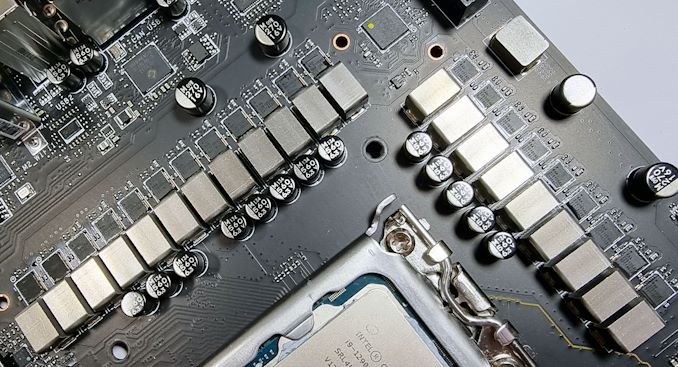
The 19+2 phase power delivery on the MSI MEG Z690 Unify (operating at 19+1)
Testing Methodology
Our method of testing is if the power delivery and its heatsink are effective at dissipating heat. We do this by running an intensely heavy CPU workload for a prolonged method of time. We apply an overclock, which is deemed safe and at the maximum that the silicon on our testbed processor allows. We then run the Prime95 with AVX2 enabled under a torture test for an hour at the maximum stable overclock we can, which puts insane pressure on the processor. We collect our data via three different methods which include the following:
- Taking a thermal image from a birds-eye view after an hour with a Flir Pro thermal imaging camera
- Securing two probes onto the rear of the PCB, right underneath CPU VCore section of the power delivery for better parity in case a probe reports a faulty reading
- Taking a reading of the VRM temperature from the sensor reading within the HWInfo monitoring application
The reason for using three different methods is that some sensors can read inaccurate temperatures, which can give very erratic results for users looking to gauge whether an overclock is too much pressure for the power delivery handle. With using a probe on the rear, it can also show the efficiency of the power stages and heatsinks as a wide margin between the probe and sensor temperature can show that the heatsink is dissipating heat and that the design is working, or that the internal sensor is massively wrong. To ensure our probe was accurate before testing, I binned 10 and selected the most accurate (within 1c of the actual temperature) for better parity in our testing.
To recreate a real-world testing scenario, the system is built into a conventional desktop chassis which is widely available. This is to show and alleviate issues when testing on open testbeds, which we have done previously, which allows natural airflow to flow over the power delivery heatsinks. It provides a better comparison for the end-user and allows us to mitigate issues where heatsinks have been designed with airflow in mind and those that have not. The idea of a heatsink is to allow effective dissipation of heat and not act as an insulator, with much more focus from consumers over the last couple of years on power delivery componentry and performance than in previous years.
For thermal imaging, we use a Flir One camera to indicate where the heat is generated around the socket area, as some designs use different configurations, and an evenly spread power delivery with good components will usually generate less heat. Manufacturers who use inefficient heatsinks and cheap out on power delivery components should run hotter than those who have invested. Of course, a $700 flagship motherboard is likely to outperform a cheaper $100 model under the same testing conditions, but it is still worth testing to see which vendors are doing things correctly.
Thermal Analysis Results

We measured 73.1ºC on the hottest part of the CPU socket during our testing
The MSI MEG Z690 Unify has a premium 21-phase power delivery which is split into nineteen for the CPU and two for the SoC. MSI is using a Renesas RAA229131 20-channel PWM controller operating at 19+1, with the two Renesas RAA22010540 105 A power stages operating in parallel with each other for the SoC. The CPU section is more robust, with nineteen Renesas RAA22010540 105 A power stages providing a maximum output of 1995 A. Keeping things cool is large pair of aluminum heatsinks that are interconnected by a single heat pipe. The large rear panel cover provides extra surface area, and the channeled fins should prove effective when installed into a chassis with adequate passive airflow.
Looking at how the MSI MEG Z690 Unify stacks up against other boards of a similar pedigree in terms of power delivery thermals, it didn’t perform too badly. We observed a maximum temperature of 78°C from the integrated VRM thermal sensor, with temperatures of 80°C and 81°C from our pair of K-type thermocouples respectively. While the Unify isn’t the coolest that we’ve tested so far, it was still well within an acceptable range where VRM thermals shouldn’t cause any concern. Power delivery thermals certainly wouldn’t be the limiting factor here, with CPU thermals much more likely to cause problems when overclocking than the VRMs.
Along with the launch of Intel’s 12th generation processors came a new socket (LGA1700), new features such as PCIe 5.0, support for DDR5 memory, and a new hybrid core architectural design. Intel also launched its Z690 chipset, and along with it, all of the motherboard vendors combined launched over 80+ new models for users to select from. More than 50 of these new Z690 models support DDR5, while more than 30 are available for users planning to use DDR4 memory. This means users now have more choices in terms of motherboard availability than there ever has been before on a single chipset. While many users across the internet have complained about how expensive some of these ‘premium’ and flagship models cost upwards of $1000, at Newegg, prices start at $210 for the DDR4 models and $230 for the DDR5 models (at the time of writing).
One of the models aiming to capture the imagination of users looking to build a premium Alder Lake system for either performance or gaming in a turbulent market is the MSI MEG Z690 Unify. A representative of its premium MEG (Enthusiast Gaming) series, the Z690 Unify combines an all-black RGBless aesthetic with some gnarly features designed to make it a solid all-around option on paper.
Starting off with some of the main features, it includes support for DDR5-6666 memory (128 GB over four slots), which despite still being in its infancy, is likely to be something we see more as Intel improves on its memory controller and memory manufacturers find the sweet spot in the manufacturing process. Other notable features include five M.2 slots, with four offering support for PCIe 4.0 x4 and one with PCIe 3.0 x4 bandwidth, while MSI also has two full-length slots with support for PCIe 5.0 x16 or x8/x8, while MSI also includes a half-length slot that is locked down to PCIe 3.0 x4.
MSI also includes a decent controller set, with two Intel I225-V 2.5 GbE controllers offering one Ethernet port each on the rear panel and an Intel AX210 Wi-Fi 6E CNVi making the most of Intel integrated PHY on the chipset. Other utilized features of Z690 by MSI here include two USB 3.2 G2x2 Type-C ports, with one on the rear panel and one via a front panel header, along with a stack of seven USB 3.2 G2 Type-A ports, all of which are on the rear panel. This is plenty of high-speed connectivity for users with many USB devices and those with devices that can utilize the extra bandwidth offered by G2. Onboard audio options include a Realtek ALC4080 HD audio codec, which powers five 3.5 mm audio jacks and S/PDIF optical output on the rear.
Touching on the performance, the MSI MEG Z690 Unify is competitive against similar models that we’ve tested so far, but we do have plenty of Z690 models to compare against it in the future. As it stands, the Z690 Unify did well in our system, compute, and gaming testing, with competitive POST time, solid DPC latency, and decent power consumption figures. We observed no weird anomalies during any part of our testing with this board.
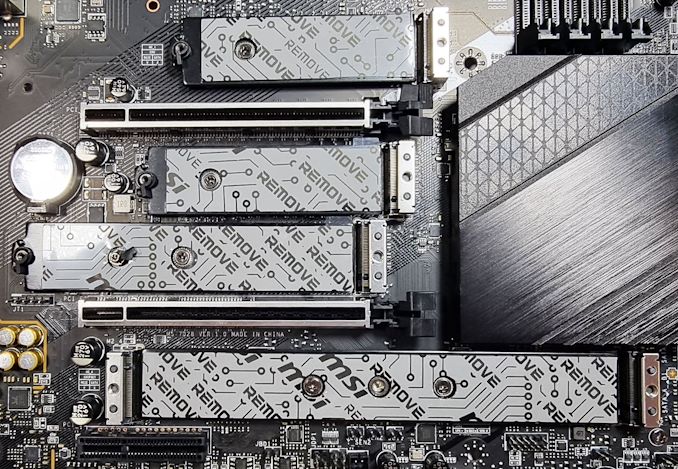
I heard you like M.2, so I put some storage in your storage…
In our overclocking and VRM thermal testing, the MSI MEG Z690 Unify showed that it could do well under the pressure of plenty of CPU VCore and frequency applied to our Core i9-12900K’s P-cores. For overclocking, the Z690 Unify is a solid contender with its large 21-phase (19+2) power delivery operating in a 19+1 configuration with premium 105 A power stages throughout. We did notice some overzealous levels of VDroop on the CPU V-Core. Still, despite running into thermal limitations, we managed to achieve an all P-Core stable overclock of 5.3 GHz, which undoubtedly caused thermal throttling. The VRM thermals of the Z690 Unify were also competitive, and we have no doubts that with more aggressive CPU cooling, there’s even more potential to be squeezed out of Alder Lakes silicon.
Final Thoughts: Is a $490 Z690 Board Mid-range, Premium, or Overpriced?
When it comes to justifying the price of Z690 motherboards, there’s been a lot of furore from users on the internet since the launch of Z690 around the vendor’s current pricing. I agree with the point that motherboard pricing has progressively increased with each generation. The fact is, so have other components, technologies, and it has always been the case that having the best just inherently costs more. The problem isn’t really at the upper end of the stack with expensive flagships, but the cost of what users consider to be entry-level and mid-range—even looking at one of the cheapest Z690 models available, priced at $210. Unfortunately, it doesn’t really cater to ‘entry-level’ users anymore. For a more affordable entry point onto Alder Lake, a whole host of B660, H670, and H610 models are available.
Focusing on the MSI MEG Z690 Unify, it has an MSRP of $490 and is currently available at Newegg for this price. In terms of competition, there’s the ASRock Z690 PG Velocita ($470), the ASUS ROG Strix Z690-E Gaming WIFI ($470), and the GIGABYTE Z690 Aorus Master ($470). Aside from the Z690 Aorus Master, which offers 10 GbE, the MSI is the next best in terms of networking with dual 2.5 GbE on the rear panel and Wi-Fi 6E and support for five M.2 drives. Much of the feature sets across all of the models mentioned above are pretty much the same.
Summarising the MSI MEG Z690 Unify up, it’s a competitive model at the $450-500 price point for users looking to push Intel’s Alder Lake processors above and beyond its already impressive performance at stock. The Unify is more than worthy of consideration for users looking for a premium foundation for an Intel 12th gen and DDR5 performance-focused system from the premium power delivery, solid network array, and many rear panel USB 3.2 G2 ports.

